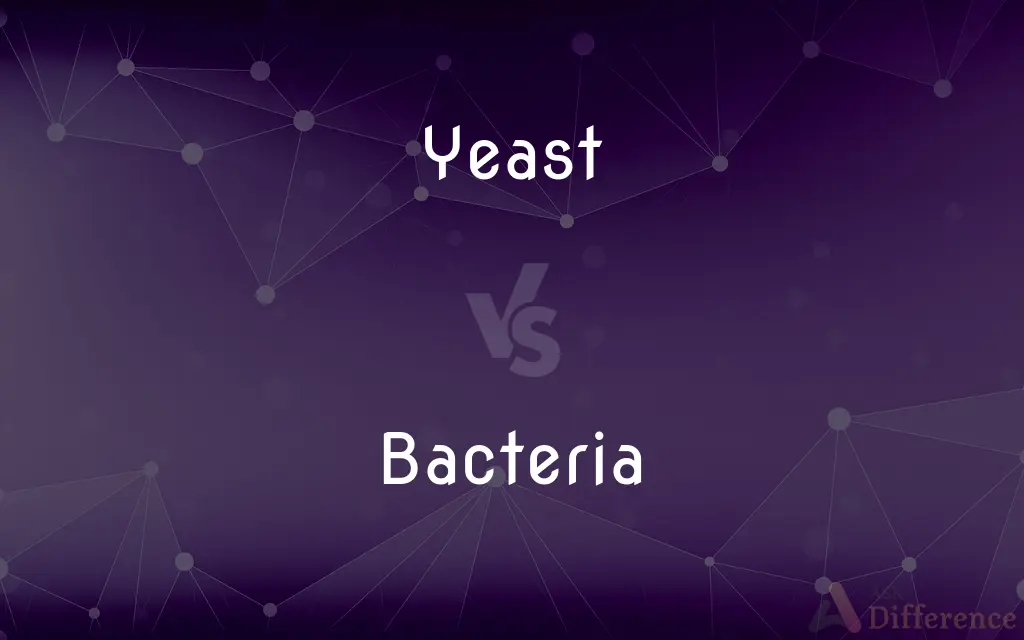Yeast vs. Bacteria — What's the Difference?
Edited by Tayyaba Rehman — By Maham Liaqat — Updated on April 16, 2024
Yeast are eukaryotic, single-celled fungi used in fermentation, while bacteria are prokaryotic organisms that play diverse roles in ecosystems and human health.

Difference Between Yeast and Bacteria
Table of Contents
ADVERTISEMENT
Key Differences
Yeast cells are eukaryotic, meaning they have a true nucleus enclosed in a nuclear membrane, which contains their genetic material. On the other hand, bacteria are prokaryotic organisms, lacking a true nucleus and instead having their DNA free-floating within the cell.
Yeast is primarily known for its role in fermentation, converting sugars into alcohol and carbon dioxide, which is crucial in baking and brewing. Bacteria, however, play a broader role, involved in processes ranging from fermentation to decomposition, and even in disease causation.
The size of yeast cells generally ranges from 3 to 40 micrometers in diameter, making them larger than most bacteria, which typically range from 0.5 to 5 micrometers. This size difference is significant under microscopic examination.
While yeast thrives in sugar-rich environments, beneficial for industries like baking and alcohol production, bacteria can inhabit a vast array of environments, from extreme heat to icy waters, and can also be found in almost every ecosystem on Earth.
Comparison Chart
Cellular Organization
Eukaryotic (true nucleus)
Prokaryotic (no true nucleus)
ADVERTISEMENT
Role in Industry
Fermentation in baking, brewing
Fermentation, decomposition, bioremediation
Reproduction Method
Budding
Binary fission
Size
3-40 micrometers
0.5-5 micrometers
Environmental Adaptation
Prefers sugar-rich environments
Thrives in diverse environments
Compare with Definitions
Yeast
Primarily reproduces through budding.
In the lab, we observed yeast cells budding off new yeast cells.
Bacteria
Capable of reproducing through binary fission.
Bacterial colonies can grow extremely quickly under optimal conditions.
Yeast
A type of fungus that is used in baking and brewing for fermentation.
The yeast in the dough helps bread rise by producing carbon dioxide.
Bacteria
Can inhabit extreme environments, from hot springs to polar ice.
Thermophilic bacteria thrive in the boiling temperatures of geothermal vents.
Yeast
Yeast cells are eukaryotic, containing a nucleus.
Under the microscope, the yeast cell's nucleus is clearly visible.
Bacteria
Play crucial roles in ecosystems and human health.
Gut bacteria are essential for digesting certain types of fiber.
Yeast
Used commercially in the production of ethanol.
Yeast fermentation is a key step in the production of biofuels.
Bacteria
Microscopic, single-celled organisms that can be found in various environments.
Bacteria in the soil help decompose organic material.
Yeast
Thrives in moist, sugar-rich environments.
Yeast is added to sweet doughs to ensure effective fermentation.
Bacteria
Bacteria lack a nucleus and other membrane-bound organelles.
Bacterial cells divide rapidly due to their simple structure.
Yeast
Yeasts are eukaryotic, single-celled microorganisms classified as members of the fungus kingdom. The first yeast originated hundreds of millions of years ago, and at least 1,500 species are currently recognized.
Bacteria
Bacteria ( (listen); common noun bacteria, singular bacterium) are a type of biological cell. They constitute a large domain of prokaryotic microorganisms.
Yeast
A microscopic fungus consisting of single oval cells that reproduce by budding, and capable of converting sugar into alcohol and carbon dioxide.
Bacteria
Plural of bacterium.
Yeast
Any of numerous fungi that exhibit a one-celled growth form and reproduce by budding, including certain candidas that can cause infections in humans.
Bacteria
(US) A type, species, or strain of bacterium.
Yeast
Froth consisting of yeast cells together with the carbon dioxide they produce in the process of fermentation, present in or added to fruit juices and other substances in the production of alcoholic beverages.
Bacteria
Alternative form of bacterium.
Yeast
A powdered or compressed commercial preparation of yeast cells, used chiefly as a leavening agent or as a dietary supplement.
Bacteria
Lowlife, slob (could be treated as plural or singular).
Yeast
An agent of ferment or activity
Political agitators who are the yeast of revolution.
Bacteria
An oval bacterium, as distinguished from a spherical coccus or rod-shaped bacillus.
Yeast
An often humid, yellowish froth produced by fermenting malt worts, and used to brew beer, leaven bread, and also used in certain medicines.
Bacteria
See Bacterium.
Yeast
A single-celled fungus of a wide variety of taxonomic families.
Bacteria
(microbiology) single-celled or noncellular spherical or spiral or rod-shaped organisms lacking chlorophyll that reproduce by fission; important as pathogens and for biochemical properties; taxonomy is difficult; often considered plants
Yeast
A true yeast or budding yeast in order Saccharomycetales.
Yeast
Candida, a ubiquitous fungus that can cause various kinds of infections in humans.
Yeast
(figuratively) A frothy foam.
Yeast
To ferment.
Yeast
(of something prepared with a yeasted dough) To rise.
Yeast
To exaggerate.
Yeast
The foam, or troth (top yeast), or the sediment (bottom yeast), of beer or other in fermentation, which contains the yeast plant or its spores, and under certain conditions produces fermentation in saccharine or farinaceous substances; a preparation used for raising dough for bread or cakes, and making it light and puffy; barm; ferment.
Yeast
Spume, or foam, of water.
They melt thy yeast of waves, which marAlike the Armada's pride, or spoils of Trafalgar.
Yeast
A form of fungus which grows as individual rounded cells, rather than in a mycelium, and reproduces by budding; esp. members of the orders Endomycetales and Moniliales. Some fungi may grow both as a yeast or as a mycelium, depending on the conditions of growth.
Yeast
A commercial leavening agent containing yeast cells; used to raise the dough in making bread and for fermenting beer or whiskey
Common Curiosities
In what industries are yeast and bacteria important?
Yeast is crucial in baking and brewing, whereas bacteria are vital in various sectors, including health, environmental management, and biotechnology.
What are the size differences between yeast and bacteria?
Yeast cells are generally larger, ranging from 3 to 40 micrometers, whereas bacteria are smaller, typically 0.5 to 5 micrometers.
Can both yeast and bacteria cause diseases?
While some bacteria are known to cause diseases, yeast infections are generally less common but can occur, especially in immunocompromised individuals.
How do yeast and bacteria reproduce?
Yeast reproduce by budding, and bacteria reproduce by binary fission.
What is the primary cellular difference between yeast and bacteria?
Yeast are eukaryotic with a nucleus, while bacteria are prokaryotic and lack a nucleus.
Are yeast and bacteria used in medicine?
Bacteria are used in the production of antibiotics and probiotics, whereas yeast is used in dietary supplements and research.
How do yeast and bacteria respond to antibiotics?
Antibiotics typically target bacteria and are generally ineffective against yeast, which require antifungal treatments.
What are the health implications of yeast and bacteria?
While bacteria can be pathogenic causing diseases, beneficial bacteria are crucial for digestion and health; yeast also plays a role in food production and some health conditions.
How do the roles of yeast and bacteria in fermentation differ?
Yeast primarily converts sugars to alcohol and CO2, beneficial in brewing and baking, while bacteria can produce a variety of fermentation products, including acids and gases.
Do yeast and bacteria have different nutritional requirements?
Yeast primarily feeds on sugars, while bacteria have more diverse nutritional capabilities, including the ability to decompose complex organic substances.
Where can yeast and bacteria be found in the environment?
Yeast are commonly found in sugary environments like fruits and nectar, while bacteria are ubiquitous and can thrive in almost any environment.
What are the physical structures of yeast and bacteria?
Yeast cells have a more complex structure with organelles, while bacteria are simpler with no internal compartments.
What are the benefits of bacteria in ecosystems?
Bacteria play essential roles in nutrient cycling, decomposing organic matter, and maintaining healthy ecosystems.
How can yeast and bacteria be observed in a laboratory?
Both can be cultured and observed under a microscope, but yeast cells are larger and easier to distinguish due to their eukaryotic structure.
How do yeast contribute to food production?
Yeast is essential in the production of bread, beer, and wine through the fermentation process.
Share Your Discovery

Previous Comparison
Friendly vs. Friendship
Next Comparison
Hypoglycemia vs. HyperglycemiaAuthor Spotlight
Written by
Maham LiaqatEdited by
Tayyaba RehmanTayyaba Rehman is a distinguished writer, currently serving as a primary contributor to askdifference.com. As a researcher in semantics and etymology, Tayyaba's passion for the complexity of languages and their distinctions has found a perfect home on the platform. Tayyaba delves into the intricacies of language, distinguishing between commonly confused words and phrases, thereby providing clarity for readers worldwide.














































